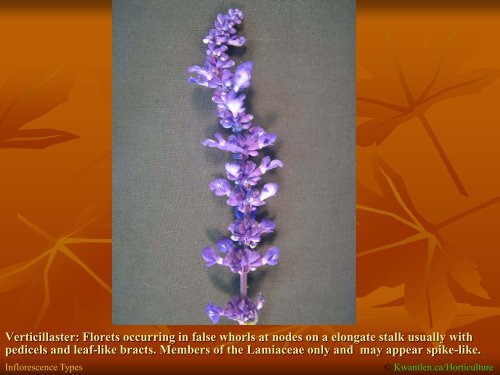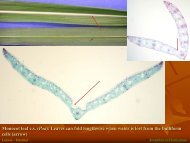Inflorescence Types - Horticulturebc.info
Inflorescence Types - Horticulturebc.info
Inflorescence Types - Horticulturebc.info
Create successful ePaper yourself
Turn your PDF publications into a flip-book with our unique Google optimized e-Paper software.
Verticillaster: Florets occurring in false whorls at nodes on a elongate stalk usually with<br />
pedicels and leaf-like bracts. Members of the Lamiaceae only and may appear spike-like.<br />
<strong>Inflorescence</strong> <strong>Types</strong> © Kwantlen.ca/Horticulture
Cyme: the growing tip becomes a floret before more arise from axillary buds. May apprea<br />
corymb-like and sometimes head inflorescences are arranged in cymes.<br />
<strong>Inflorescence</strong> <strong>Types</strong> © Kwantlen.ca/Horticulture
Raceme: elongated inflorescence with floret pedicels of about equal length that develop<br />
along a rachis.<br />
<strong>Inflorescence</strong> <strong>Types</strong> © Kwantlen.ca/Horticulture
Panicle: a main axis supports several racemes so that the inflorescence appears branched.<br />
Term often applied to any highly branched, elongate, inflorescence whose flowering<br />
sequence is s unclear, even if cymose.<br />
<strong>Inflorescence</strong> <strong>Types</strong> © Kwantlen.ca/Horticulture
Catkin: florets unisexual, apetalous, and tightly packed together on a rachis that<br />
usually droops downward (found only in some woody dicots, e.g. willow, birch, alder, oak).<br />
<strong>Inflorescence</strong> <strong>Types</strong> © Kwantlen.ca/Horticulture
Spikelet: inflorescence consisting of an axis (rachilla), above two bracts (glumes) and one or<br />
more very small florets with perianths reduced paired bracts (the palea and lemma).<br />
Spikelets may be arranged in spikes, racemes, or panicles. Found in grasses and sedges.<br />
<strong>Inflorescence</strong> <strong>Types</strong> © Kwantlen.ca/Horticulture
Spadix: racemose inflorescence consisting of many tiny florets on an enlarged fleshy axis<br />
which is usually partially enclosed by a large bract (the spathe). In the Araceae only.<br />
<strong>Inflorescence</strong> <strong>Types</strong> © Kwantlen.ca/Horticulture
Spike: inflorescence elongate and raceme-like but with very short or no pedicels.<br />
<strong>Inflorescence</strong> <strong>Types</strong> © Kwantlen.ca/Horticulture
Head (Asteraceae): florets small, closely packed, lack pedicels, and arise from a flattened<br />
axis that is surrounded or subtended by bracts to appear as a large flower. Head<br />
inflorescences are commonly arranged in cymes and may be small.<br />
<strong>Inflorescence</strong> <strong>Types</strong> © Kwantlen.ca/Horticulture
Head: florets small, closely packed, lack pedicels, and arise from a flattened axis that is<br />
surrounded or subtended by bracts to appear as a large flower. Mainly in Asteraceae.<br />
<strong>Inflorescence</strong> <strong>Types</strong> © Kwantlen.ca/Horticulture
Umbel: pedicels (and rays if a compound umbel) of about equal length all arising from the<br />
apex of the peduncle. Mainly occur in the Apiaceae.<br />
<strong>Inflorescence</strong> <strong>Types</strong> © Kwantlen.ca/Horticulture
Corymb: florets are formed on lateral stalks of different length, the longest being at the<br />
base creating a flat-topped inflorescence.<br />
<strong>Inflorescence</strong> <strong>Types</strong> © Kwantlen.ca/Horticulture
Cyathium: consists of a simple female floret (one pistil) in the center surrounded by many<br />
simple male florets (one stamen each) on bracts. F.Y.I. - Found only in the Euphorbiaceae.<br />
<strong>Inflorescence</strong> <strong>Types</strong> © Kwantlen.ca/Horticulture
Use the<br />
Key to the Basic <strong>Inflorescence</strong> <strong>Types</strong><br />
in your lab manual or lecture handouts<br />
to identify the following unknowns .<br />
Practice identifying inflorescence unknowns<br />
<strong>Inflorescence</strong> <strong>Types</strong> © Kwantlen.ca/Horticulture
Unknown #1<br />
<strong>Inflorescence</strong> <strong>Types</strong> © Kwantlen.ca/Horticulture
Unknown #2<br />
<strong>Inflorescence</strong> <strong>Types</strong> © Kwantlen.ca/Horticulture
Unknown #3<br />
<strong>Inflorescence</strong> <strong>Types</strong> © Kwantlen.ca/Horticulture
Unknown #4<br />
<strong>Inflorescence</strong> <strong>Types</strong> © Kwantlen.ca/Horticulture
Unknown #5<br />
<strong>Inflorescence</strong> <strong>Types</strong> © Kwantlen.ca/Horticulture
Unknown #6<br />
<strong>Inflorescence</strong> <strong>Types</strong> © Kwantlen.ca/Horticulture
Unknown #7<br />
<strong>Inflorescence</strong> <strong>Types</strong> © Kwantlen.ca/Horticulture
Unknown #8<br />
<strong>Inflorescence</strong> <strong>Types</strong> © Kwantlen.ca/Horticulture
Unknown #9<br />
<strong>Inflorescence</strong> <strong>Types</strong> © Kwantlen.ca/Horticulture
Unknown #10<br />
<strong>Inflorescence</strong> <strong>Types</strong> © Kwantlen.ca/Horticulture
Unknown #11<br />
<strong>Inflorescence</strong> <strong>Types</strong> © Kwantlen.ca/Horticulture
Answer Key<br />
1) Catkin<br />
2) Verticillaster<br />
3) Head<br />
4) Corymb<br />
5) Raceme<br />
6) Panicle<br />
7) Spikelet (arranged in a panicle)<br />
8) Cyme<br />
9) Spadix<br />
10) Spike<br />
11) Umbel<br />
<strong>Inflorescence</strong> <strong>Types</strong> © Kwantlen.ca/Horticulture




